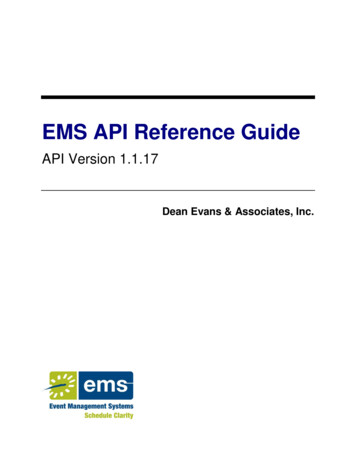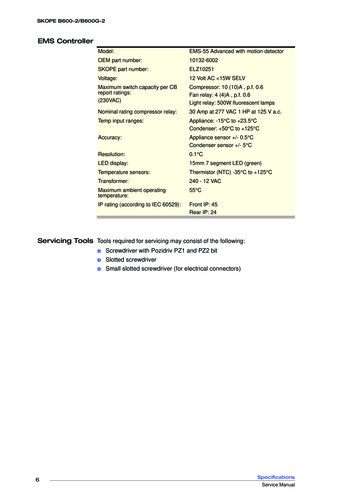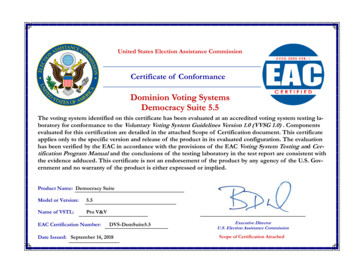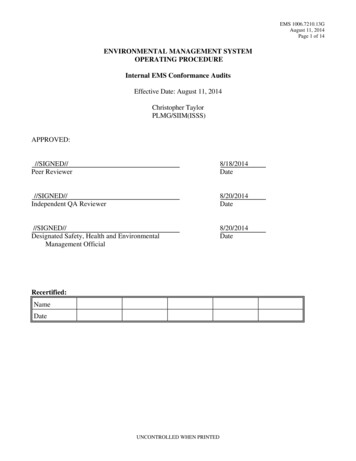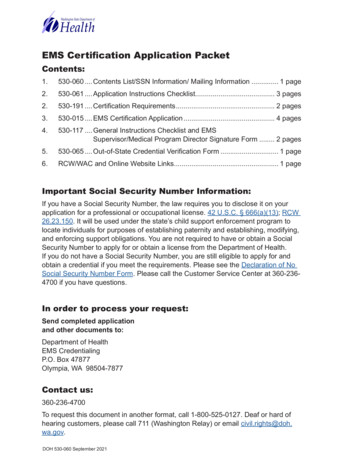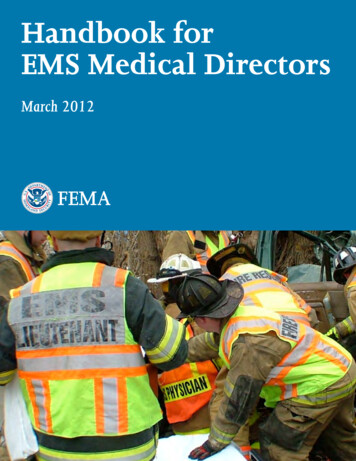
Transcription
Handbook forEMS Medical DirectorsMarch 2012
This page was intentionally left blank.
U.S. Fire AdministrationMission StatementWe provide National leadership to foster a solid foundationfor our fire and emergency services stakeholders inprevention, preparedness, and response.
This page was intentionally left blank.
PrefacePrefaceColleagues:The Department of Homeland Security (DHS) Office of Health Affairs (OHA) and the U.S. Fire Administration (USFA) are pleased to deliver this Handbook for EMS Medical Directors of local departments and agenciesinvolved in emergency medical services (EMS) response.Medical directors provide critical oversight and medical direction to ensure that effective emergency medical care is provided to millions of patients throughout the United States. In addition to providing medicaloversight and direction, EMS medical directors support EMS personnel and first responders through training, protocol development, and resource deployment advice. This handbook provides a baseline overviewof key roles and responsibilities to assist current and prospective medical directors in performing their important missions.On behalf of the U.S. DHS, we thank you for your service to the Nation’s EMS.Sincerely yours,Alexander G. Garza, M.D., M.P.H.Assistant Secretary for Health Affairs andChief Medical OfficerErnest Mitchell, Jr.U.S. Fire Administratori
This page was intentionally left blank.ii
Table of ContentsTable of ContentsPreface. iAcknowledgements. 1Introduction. 3The EMS Agency and Its Stakeholders. 5Overview. 5EMS History. 5The Modern EMS System. 9EMS Agency Design Types. 10Multiple-Role EMS Agency. 10Single-Role EMS Agency. 11Hospital-Based EMS Transport Agency. 11Private EMS Agency. 11Third-Service EMS Agency. 11Public Utility EMS Agency. 11EMS Agency Staffing Types. 11Career . 12Volunteer. 12Combination. 12Types of Response Service. 12Single-Tier Response Service. 12Tiered Response Service. 13Resource Deployment. 13Fixed Deployment. 13Dynamic Deployment. 13Emergency Medical Dispatch. 13Emergency Response Components . 14Disasters or Multiple and Mass Casualty Incidents. 15Technical Rescue or Medical Search and Rescue. 15Special or Mass Gatherings Events. 16Hazardous Materials. 16Wildland. 16Tactical EMS. 17Becoming a Medical Director. 19Role and Purpose of the Medical Director. 19Scope of Responsibility. 19Agency Oversight. 19Education and Training of the Medical Director. 20Postgraduate Education. 20State Requirements. 20Consensus Standards and Professional Associations. 21Agency Training. 22Continuing Education for the Medical Director. 22Affiliation Agreements. 22iii
Table of ContentsHire/Employee. 23Independent Contractor. 23Memorandum of Understanding and Memorandum of Agreements. 23Performance Expectations. 24Compensation and Benefits. 25Workers’ Compensation. 25Continuing Education. 25IRS Requirements. 25Dissolution. 26Liability Coverage. 26Medical Malpractice Coverage. 26Errors and Omission Coverage. 27General Liability Coverage. 27Directors’ and Officers’ Coverage. 27Indemnification. 27Areas of Caution for Medical Directors. 27Hiring and Promotional Decisions. 28Provider Disciplinary Actions. 28Budget and Procurement Regulations. 28Conflict of Interest Considerations. 28Agency Oversight. 31Workforce Oversight and Supervision. 31Provisions of Patient Care. 32Protocols. 32Standing Orders. 32Online Medical Direction. 33Offline Medical Direction. 33Medical Director in the Field. 33Incident Command System . 34EMS Scope of Practice. 35Education Standards. 36National EMS Educational Standards. 36EMS Provider Continuing Education Program Development. 37Provider Competency Verification. 38Performance-Based Organizations. 38Quality Improvement. 38Types of Quality Improvement. 40Six Sigma in EMS. 41HIPAA and Quality Improvement. 42Performance Measures. 42Benchmarking. 43Best Practices. 44Ambulance Service Accreditation . 44EMS Research. 44Health and Safety of Medical Directors and Providers. 45Patient Safety. 46Agency Dynamics. 47iv
Table of ContentsAmbulance Service Certificate of Need . 47Public Relations . 47Media Inquiries . 47EMS Advocacy. 47Credentialing in EMS . 48EMS Education Program Dynamics. 48Accreditation of Education Programs. 48Certification of Providers. 49Recertification of EMS Providers. 50Agency Compliance Considerations. 51Collective Bargaining Agreements. 51Right to Work States. 52Industry Regulations and Standards. 52Fiscal Management Issues. 52Budgeting. 52Federal and State Funding Sources. 52Local Funding Sources. 53Agency-Level Funding Sources. 53Revenue Recovery Sources. 54Funding for Medical Directors. 54Apparatus and Equipment. 54Ambulance Design . 54EMS Equipment and Technology. 54Medication Supply and Storage Practices. 55Moving Forward as a Medical Director. 57Appendix A: Checklist for the New Medical Director. 59Appendix B: Glossary. 61Appendix C: EMS Acronyms. 65Appendix D: Sample Organization Charts. 67Appendix E: Sample Affiliation Agreement. 71Appendix F: Sample Liability Insurance Form . 75Appendix G: Industry Regulations and Standards. 77Occupational Safety and Health Administration. 77National Fire Protection Association. 77American Society for Testing and Materials. 78Appendix H: Performance Measures. 79Appendix I: Endnotes. 81v
This page was intentionally left blank.vi
AcknowledgementsAcknowledgementsThe Handbook for EMS Medical Directors was developed by the International Association of Fire Chiefs (IAFC) aspart of a Cooperative Agreement with the Department of Homeland Security (DHS), Federal EmergencyManagement Agency (FEMA), U.S. Fire Administration (USFA), and was supported by DHS, Office of HealthAffairs (OHA). The IAFC Emergency Medical Services (EMS) Section provided oversight in the developmentof the handbook.A project team representing EMS stakeholder groups worked together to develop, contribute, and author thehandbook. The following individuals are extended the greatest amount of appreciation for their expertise,effort, and dedication throughout the handbook development process:Edward Dickinson, MD, NREMT-P, FACEPNational Association of EMS Physicians (NAEMSP)Battalion Chief Jennie L. Collins, NREMT-PLead Technical WriterGeorge Lindbeck, MDNational Association of State EMS Officials(NASEMSO)Lieutenant James H. Logan, BS, EMT-PTechnical WriterChief Gary Ludwig, MS, EMT-PInternational Association of Fire Chiefs (IAFC)Lori Moore-Merrell, DrPHInternational Association of Fire Fighters (IAFF)Chief Mary Beth Michos (ret.), MSChief Administrative and Operations OfficerInternational Association of Fire Chiefs (IAFC)Victoria Lee, MPAProgram ManagerInternational Association of Fire Chiefs (IAFC)Richard W. Patrick, MS, CFO, EMT-PU.S. Department of Homeland Security (DHS),Office of Health Affairs (OHA)Bill Troup, MBAFire Program SpecialistU.S. Fire Administration (USFA)National Fire Data Center (NFDC)Chief Ed Plaugher (ret.), BS, EFOAssistant Executive DirectorInternational Association of Fire Chiefs (IAFC)Melissa Milan, MDTechnical WriterIn addition to the project team, many industry professionals contributed time, information, and efforts toaid in the production of this handbook. Industry stakeholder groups reviewed and provided feedback during the handbook’s production and their efforts are greatly appreciated. Listed below are the stakeholdergroups and their representatives who reviewed the handbook.American Ambulance Association (AAA)Jeffrey M. Goodloe, MD, NREMT-P, FACEPInternational Association of Fire Fighters (IAFF)Lori Moore-Merrell, DrPHAmerican College of Emergency Physicians (ACEP)David J. Schoenwetter, DO, FACEPNational Association of EmergencyMedical Technicians (NAEMT)Jason Kodat, MD, EMT-PInternational Association of EMS Chiefs (IAEMSC)John Peruggia, BSHS, EFO, EMT-PInternational Association of Fire Chiefs (IAFC)Gary Ludwig, MS, EMT-PIAFC’s Safety, Health and Survival SectionEd Nied, MST, NREMT-PNational Association of EMS Educators (NAEMSE)Angel Clark Burba, MS, NREMT-P, NCEENational Association of EMS Physicians (NAEMSP)Edward Dickinson, MD, NREMT-P, FACEP1
AcknowledgementsNational Association of State EMS Officials(NASEMSO)George Lindbeck, MDNational EMS Management Association (NEMSMA)Jerry Allison, MD, MSNational Fire Protection Association (NFPA)Ken Holland, FF/EMT-P, BA, MBA/PANational Volunteer Fire Council (NVFC)Ken KnipperU.S. Department of Homeland Security (DHS),Office of Health Affairs (OHA)Sandy Bogucki, MD, Ph.D., FACEPU.S. Department of Homeland Security (DHS),Office of Health Affairs (OHA)Michael Zanker, MDSenior Medical AssociateU.S. Department of Homeland Security (DHS),Office of Health Affairs (OHA)Michael Zanker, MD, FACEP,Senior Medical OfficerU.S. Department of TransportationNational Highway Traffic Safety Administration(NHTSA) Office of EMSDrew DawsonOther technical input was received from:Franklin D. Pratt, M.D., MPHTM, FACEPMedical Director, Los Angeles County (CA)Fire DepartmentDoug Wolfberg of Page, Wolfberg, and Wirth, LLCThe project team and sponsoring agencies extend their appreciation for the professional support and cooperation provided during the review process. The efforts of the project team, contributors, and authors willaid in the education of those who read the handbook and will result in improved understanding of the multifaceted role of an EMS agency medical director.2
IntroductionIntroductionThe position of an emergency medical services (EMS) agency medical director allows the opportunity for aphysician to become engaged in the unique and ever-evolving realm of out-of-hospital care, a clinical practice offering a distinct set of challenges, and rewarding impacts in improving a community’s emergencymedical care abilities. For most, the driving force behind the desire to become an EMS agency medicaldirector stems from a deep passion for helping patients in times of marked acute medical need wheneverand wherever the need appears. Yet, understanding the nuances involved in the oversight and direction ofan EMS agency requires specialized knowledge, skills, and abilities beyond the typical curriculum of emergency medicine or alternative acute care medical practices. It is for this precise reason that EMS has beenrecently recognized by the American Board of Medical Specialties as a formal physician subspecialty.The purpose of this handbook is to provide assistance to both new and experienced medical directors asthey strive to provide the highest quality of out-of-hospital emergency medical care to their communitiesand foster excellence within their agencies. The handbook will provide the new medical director with afundamental orientation to the roles that define the position of the medical director while providing theexperienced medical director with a useful reference tool. The handbook will explore the nuances found inthe EMS industry–a challenge to describe in generalities due to the tremendous amount of diversity amongEMS agencies and systems across the Nation. The handbook does not intend to serve as an operational medical practice document, but seeks to identify and describe the critical elements associated with the position.EMS medical direction is a multidimensional activity that includes the direction and oversight of administrative, operational, educational, and clinical actions related to patient care activities. The medical directoris an integral leader in an EMS agency and will serve as the interface between the agency and the medicalcommunity. The medical director must have a collaborative and cooperative approach to working with theEMS agency, as there are many who will work in concert to ensure the agency is functioning optimally.The EMS workforce is a diverse, creative, committed, and often very street-savvy group of providers. Themedical director can be most effective by meshing the physician passions for patient beneficence, scientific discovery, ethical practices, and professional development to the enthusiasm and dedication withinthe EMS culture. Achieving success as a medical director depends on many things. Inherent among themis a tremendous amount of motivation, willingness to learn while simultaneously teaching, and enactingsolid leadership skills, all while reinforcing the roles of patient advocate, mentor, and coach. The successfulmedical director is equally analytical and resourceful. The medical director must focus on how to improvetheir agency and the service that it delivers on a continual basis. Involvement with this aspect of emergencycare can be extremely rewarding, challenging, as well as personally and professional fulfilling. Physicianselecting to pursue the role of a medical director are to be commended for their dedication and critical position they will hold in the public safety and health care arenas.The handbook’s chapters identify and discuss the components of an EMS agency and its agency stakeholders, the position of a medical director, and the medical director’s role in agency oversight. The handbookcontains appendices that include medical director’s checklist; glossary; acronym guide; sample agreement of service documents; sample liability insurance documents;3
Chapter 1 industry regulations and standards; and sample performance measures.These reference items will aid in a physician’s understanding of the general role, needs, and requirementsfor the medical director position.4
EMS Agency and Its StakeholdersThe EMS Agency and Its StakeholdersOverviewThe emergency medical services (EMS) system describes a continuum of care beginning with initial contactand response through patient care and transport to an appropriate receiving facility. EMS also has grownin its involvement in other areas of out-of-hospital care including disaster and mass casualty planning andinjury prevention. The “EMS Agenda for the Future” describes prehospital medicine as the practice of providing emergency care that is remote from a health-care facility, in all of its complexities.1An EMS agency is a coordinated arrangement of personnel, equipment, and facilities organized to respondto medical emergencies regardless of cause. Since the care of patients in the EMS arena also includes thosepatients needing movement between health-care facilities (e.g., hospital to nursing or rehabilitation facility)and not just their entry into the health-care system due to an emergency, the term out-of-hospital care isalso used to describe the EMS environment.EMS HistoryEMS can trace its roots to humble beginnings and unlikely sponsors. During the early to mid-20th century,funeral homes
Preface Preface Colleagues: The Department of Homeland Security (DHS) Office of Health Affairs (OHA) and the U.S. Fire Adminis-tration (USFA) are pleased to deliver this Handbook for EMS Medical Directors of local departments and agencies involved in emergency medical services (EMS) response.
